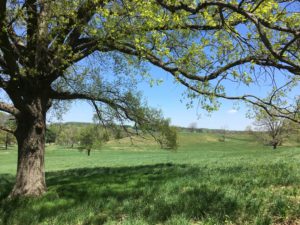Running with the Land
Conservation easements are vital to our region.


Permanently conserved land is an important part of what makes Chester County so special. Not only is our local scenery some of the most beautiful in Pennsylvania, protected land provides vital habitat for plants and animals and boosts the health of our waterways. And that’s in addition to recreational uses for hiking and enjoying nature on some conserved land.
Over more than 20 years, the Willistown Conservation Trust, along with other area organizations with a similar mission—including Brandywine Conservancy, French & Pickering Creek Conservation Trust, Land Conservancy of Southern Chester County and Natural Lands—has permanently protected thousands of acres in the Brandywine Valley from potential development.
This work also encompasses constantly striving to preserve vulnerable land from the pressures of developers and suburban sprawl. And in the case of Willistown Conservation Trust, this locally protected land allows us to make a broader impact beyond our region in such areas as bird conservation, sustainable agriculture, watershed protection, research and education.
What is a conservation easement?
The process of protecting land most commonly starts when a landowner decides to donate what’s known as a conservation easement to a land trust (or in some cases, to a government agency). A conservation easement is a legal agreement between the landowner and land trust by which the landowner retains private ownership of their land and typically enjoys certain tax benefits, while the natural and scenic resources of their land are protected and the land’s development rights restricted in perpetuity.
A conservation easement can be tailored to protect the unique conservation values of each property and meet the financial and personal needs of the landowner. For example, an easement on land containing high value wildlife habitat might focus on restricting the extent and location of development that’s permitted to protect woodland and stream corridors. Or, an easement on a working farm may be structured to facilitate farming and building structures to support farming.
How long does an easement last?
Conservation easements typically include language designed to preserve the natural, cultural and scenic resources of a property and to restrict the land’s future development. Because this type of easement exists in perpetuity (typically expressed in the agreement as “running with the land in perpetuity”), the trust’s and the landowner’s commitment to the protections afforded by the easement never ends.
In fact, this long-term nature of conservation easements is one of their greatest intrinsic strengths, ensuring the permanent protection of our precious open spaces while reinforcing the bond between the land trust and its easement community.
How does it work?
When a landowner places a conservation easement on a piece of property or purchases a property with an existing easement, both the land trust and the landowner assume responsibility for upholding the agreement’s terms. This is done with the understanding that the land trust’s role—whether as landowner or as trustee—is simply one chapter of a perpetual commitment that will extend long term.
The stewardship staff at a land trust specifically assumes responsibility for the long-term enforcement of the conservation easement as well as developing mutual respect, trust and an open channel of communication with the easement landowners.
To this end, at Willistown Conservation Trust, our priorities are to:
- Visit every easement property at least once a year to perform a physical inspection of the conserved land;
- Work closely with easement landowners who wish to make permitted improvements to their property (e.g., residential and agricultural structures, pools, run-in sheds);
- Help new landowners who have purchased an easement property understand the conservation easement’s terms, restrictions and benefits; and
- Invite and answer questions about a landowner’s specific conservation easement.
Because easements vary in scope and the degree of development restrictions, we tailor our approach for each property and welcome requests for clarification. Other land trusts have their own approaches to working with their landowners.
These relationships with easement landowners—whom we frequently refer to as “our heroes of the Willistown countryside”—are some of the most enduring and important partnerships we hold as an organization, and we work tirelessly to honor and strengthen them.
Over time as easement properties change hands and new landowners and families come into our community, Willistown Conservation Trust will be here to welcome them and ensure the permanent protection of the land that makes our community so special.
So the next time you’re driving through the preserved lands of Willistown or other areas in Chester County (which has made open space a priority for 50 years) and enjoying the scenery and respite from our busy world, remember the quiet power of this land and the effort required to achieve it.
Willistown Conservation Trust’s conserved land includes three nature preserves open to the public year round, free of charge. These preserves have scenic walking trails and abundant wildlife. Visit WCTrust.org/land/preserves for information, maps and directions and to learn more about our work.
